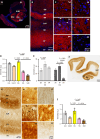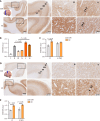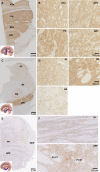Increased expression of the neuroplastin 65 protein is involved in neurofibrillary tangles and amyloid beta plaques in Alzheimer's disease
- PMID: 40574756
- PMCID: PMC12188859
- DOI: 10.5498/wjp.v15.i6.105751
Increased expression of the neuroplastin 65 protein is involved in neurofibrillary tangles and amyloid beta plaques in Alzheimer's disease
Abstract
Background: Alzheimer's disease (AD) is a progressive neurodegenerative disorder currently lacking effective therapeutic interventions. Pathological hallmarks of AD include intracellular neurofibrillary tangles (NFTs) and extracellular amyloid beta (Aβ) plaques. Neuroplastin 65 (NP65), highly expressed in the brain, has been previously shown to mitigate cognitive impairments and decrease Aβ plaques in the AD mouse model, suggesting that NP65 is involved in AD neuropathology. However, direct evidence linking NP65 expression to AD pathogenesis in human brain remains absent.
Aim: To quantify NP65 isoform expression gradients across distinct neuroanatomical regions in the healthy brain and investigate the alterations of NP65 expression in the AD brain.
Methods: Immunohistochemical, immunofluorescent and western blot analyses were used to investigate NP65 expression in 19 postmortem brains (AD = 10, controls = 9). Double immunostaining with 6E10 and or phosphorylated-microtubule-associated protein tau (AT-8, a marker for NFT) markers was performed to assess NP65 colocalization with Aβ plaques and NFTs.
Results: In controls, NP65 was highly expressed in a wide-range of brain areas. AD cases showed significantly increased NP65 immunoreactivity across multiple brain regions, including the frontal and temporal cortex, hippocampus, and cerebellum, compared to controls. Western blot analysis consistently confirmed significantly elevated NP65 expression in the hippocampus of AD patients relative to controls. Double immunostaining demonstrated partial colocalization of NP65 with NFTs and Aβ plaques in AD brain tissue.
Conclusion: Our findings demonstrate a significant increase of NP65 protein, which colocalizes with NFTs and Aβ plaques in AD brains, providing direct evidence supporting a critical role of NP65 expression in the neuropathological mechanisms of this disease.
Keywords: Alzheimer’s disease; Amyloid beta; Hippocampus; Neurofibrillary tangles; Neuroplastin 65 protein.
©The Author(s) 2025. Published by Baishideng Publishing Group Inc. All rights reserved.
Conflict of interest statement
Conflict-of-interest statement: All the authors report no relevant conflicts of interest for this article.
Figures






Similar articles
-
SMOC1 colocalizes with Alzheimer's disease neuropathology and delays Aβ aggregation.Acta Neuropathol. 2024 Nov 25;148(1):72. doi: 10.1007/s00401-024-02819-6. Acta Neuropathol. 2024. PMID: 39585417 Free PMC article.
-
Co-Aggregation of Syndecan-3 with β-Amyloid Aggravates Neuroinflammation and Cognitive Impairment in 5×FAD Mice.Int J Mol Sci. 2025 Jun 8;26(12):5502. doi: 10.3390/ijms26125502. Int J Mol Sci. 2025. PMID: 40564963 Free PMC article.
-
SMOC1 colocalizes with Alzheimer's disease neuropathology and delays Aβ aggregation.Res Sq [Preprint]. 2024 Nov 1:rs.3.rs-5229472. doi: 10.21203/rs.3.rs-5229472/v1. Res Sq. 2024. Update in: Acta Neuropathol. 2024 Nov 25;148(1):72. doi: 10.1007/s00401-024-02819-6. PMID: 39574902 Free PMC article. Updated. Preprint.
-
CSF tau and the CSF tau/ABeta ratio for the diagnosis of Alzheimer's disease dementia and other dementias in people with mild cognitive impairment (MCI).Cochrane Database Syst Rev. 2017 Mar 22;3(3):CD010803. doi: 10.1002/14651858.CD010803.pub2. Cochrane Database Syst Rev. 2017. PMID: 28328043 Free PMC article.
-
Galantamine for Alzheimer's disease.Cochrane Database Syst Rev. 2002;(3):CD001747. doi: 10.1002/14651858.CD001747. Cochrane Database Syst Rev. 2002. Update in: Cochrane Database Syst Rev. 2004 Oct 18;(4):CD001747. doi: 10.1002/14651858.CD001747.pub2. PMID: 12137632 Updated.
References
-
- Scheltens P, Blennow K, Breteler MM, de Strooper B, Frisoni GB, Salloway S, Van der Flier WM. Alzheimer's disease. Lancet. 2016;388:505–517. - PubMed
-
- Karran E, De Strooper B. The amyloid hypothesis in Alzheimer disease: new insights from new therapeutics. Nat Rev Drug Discov. 2022;21:306–318. - PubMed
LinkOut - more resources
Full Text Sources

